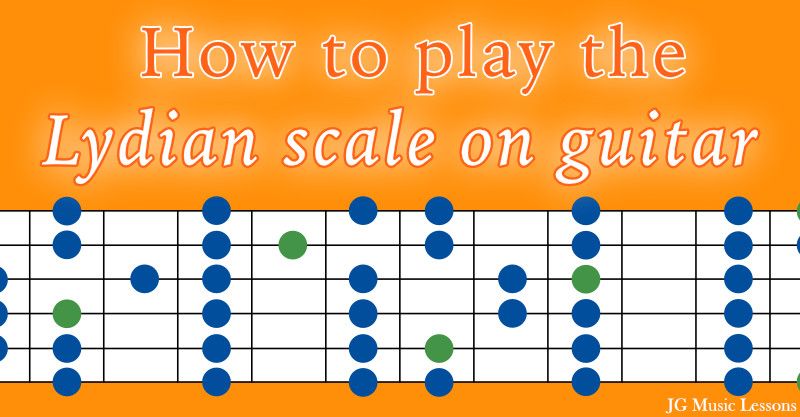The lydian scale is the fourth mode of the Major scale and is used across various music genres. It’s an essential scale you want to learn, especially for improvising on guitar.
This scale is very similar to Major scale but with a small twist by changing one of the notes which gives it uniquely bright sound.
In this lesson, we’ll cover the music theory for the lydian scale, examples in different keys, learn the 5 scale shapes, and application examples. Grab your guitar and let’s get started!
Lydian scale formula
If you start and end on the 4th degree of the Major scale, you are playing a lydian scale. For example, a C lydian scale would have the notes C, D, E, F#, G, A, and B (same notes in a G Major scale). In terms of scale degrees, the notes are root, 2, 3, #4, 5, 6, and 7.
If you notice, there is only one note difference between the lydian scale and the Major scale. The lydian scale has a sharp 4th scale degree, while the Major scale has a natural 4th degree. For example:
- A lydian scale: A, B, C#, D#, E, F#, and G#.
- A Major scale: A, B, C#, D, E, F#, and G#.
We can also look at the lydian scale formula in terms of whole and half steps. The formula would be whole, whole, whole, half, whole, whole, and half step between the scale notes. See the image below.

You can also simply think of the parent scale that a lydian scale comes from by counting a perfect 5th interval above or 3.5 whole steps above. For example, E lydian would have the same notes as an B Major scale. Or A lydian would have the same notes as an E Major scale.
Lydian scale examples with tabs
Here are some different lydian scales in music notation with guitar tabs below. The numbers above the notes on the top staff indicated which fingers to use on your fretting hand. If needed, check out how to read guitar notation symbols.
The following examples show you how to play different scales in one octave but we’ll also cover how to play beyond one octave later in this lesson.
C lydian scale example

D lydian scale example

E lydian scale example

F lydian scale example

G lydian scale example

A lydian scale example

B lydian scale example

Lydian scales chart
The following chart shows you the notes for lydian scales starting on every root note.
| Lydian scale | 1 | 2 | 3 | #4 | 5 | 6 | 7 |
|---|---|---|---|---|---|---|---|
| C lydian scale | C | D | E | F# | G | A | B |
| D lydian scale | D | E | F# | G# | A | B | C# |
| E lydian scale | E | F# | G# | A# | B | C# | D# |
| F lydian scale | F | G | A | B | C | D | E |
| G lydian scale | G | A | B | C# | D | E | F# |
| A lydian scale | A | B | C# | D# | E | F# | G# |
| B lydian scale | B | C# | D# | F | F# | G# | A# |
| Db lydian scale | Db | Eb | F | G | Ab | Bb | C |
| Eb lydian scale | Eb | F | G | A | Bb | C | D |
| Gb lydian scale | Gb | Ab | Bb | C | Db | Eb | F |
| Ab lydian scale | Ab | Bb | C | D | Eb | F | G |
| Bb lydian scale | Bb | C | D | E | F | G | A |
5 Lydian scale guitar shapes
The following section shows you the 5 lydian scale shapes throughout the guitar fretboard.
How to read the scale charts
For the charts below:
- The lowest horizontal line represents the thickest string (Low E). The top horizontal line represents the thinnest string (high E).
- The green circles represent the root note of the lydian scale and the blue notes are every scale note in between.
- The numbers inside the circles represent the suggested fingering to use on your fretting hand.
If needed, check out how to read guitar notation symbols.
Lydian scale shape 1
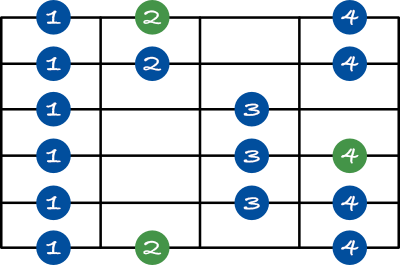
Lydian scale shape 2

Lydian scale shape 3
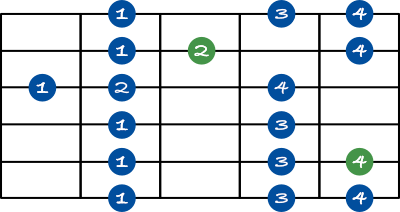
Lydian scale shape 4
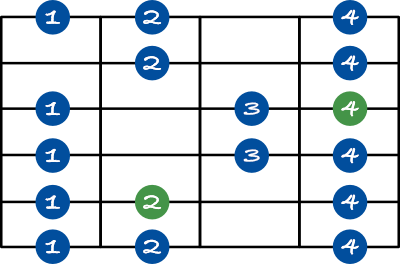
Lydian scale shape 5
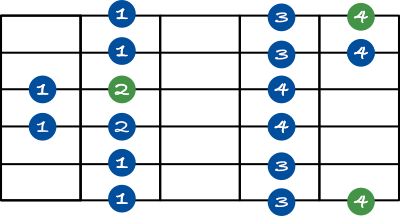
Connecting scale shapes on the fretboard
To put it all together, this is what the connected shapes look like throughout the fretboard for the C lydian scale below.

Lydian scale guitar application examples
The lydian scale generally works well over any Major chord or Major 7 chord. The raised 4th degree stands out so you want to be aware of when to use it to match the musical context.
Here are 5 scale application examples over different chords.
C lydian – application example 1
Notice that the first four notes of measure 2 outline a G Major 7 chord arpeggio. This works because G Major is the parent scale for C lydian.

E lydian – application example 2
This E lydian scale phrase example combines shapes 4 and 5.

F lydian – application example 3
This application example over an F chord includes a chromatic note in measure 1 (“and” of beat 3).

A lydian – application example 4
For this A lydian scale example, we’re using a G# minor pentatonic. This pentatonic happens to highlight these chord tones related to the root note: 7, 13, #4 (#11), 3, 9th. We’re also using an alternating pentatonic scale pattern to make the phrase sound more interesting.

G lydian – application example 5
For this example, we are using the triads A Major and G Major to create a line that highlights the G lydian sound. This soloing concept can be referred to as “triad pairs” used to highlight specific sounds in a chord.

Wrapping up
The lydian scale is an essential scale you want to learn to create more interesting guitar solos, especially for styles such as jazz or blues. In short, all you need to do is raise the 4th degree of a Major scale to play a lydian scale.
I suggest memorizing all the shapes well and then working on how to make the scale sound musical. For some ideas on how to do this, check out this lesson on how to practice scales on guitar. You may also want to learn how make your melody lines sound jazzy.
You can also see an overview of the Major scale modes and their related emotions here or learn the specific scales below:
- Ionian scale (Major scale)
- Dorian scale
- Phrygian scale
- Mixolydian scale
- Aeolian scale (minor scale)
- Locrian scale
📘 Get the free guitar practice guide here!
All the best,
JG Music Lessons
📙 Kickstart your guitar playing with our step by step guide: Guitar Essentials.
🎸 Looking for a travel or half-sized guitar? See this one.
🛠 See our other music recommendations.
🤝 Support the site to help us to create better content for you!
Level up with the FREE guitar practice guide and effectively improve your playing! 🎸
Get it sent to your email!

